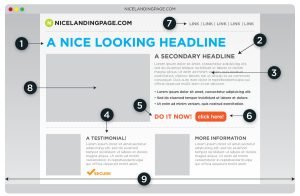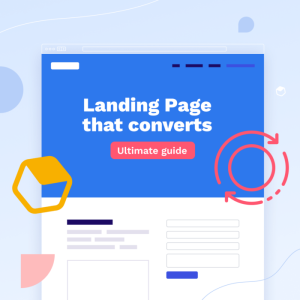The Ultimate Guide to Creating Landing Pages That Convert
Landing pages are a cornerstone of digital marketing. They serve as the entry point for potential customers and play a crucial role in converting visitors into leads or customers. However, creating a landing page that effectively converts requires careful planning, persuasive elements, and a deep understanding of your target audience. In this ultimate guide, we’ll walk you through the steps to create landing pages that not only capture attention but also drive action.
Table of Contents
- Understanding Landing Pages
- Defining Your Landing Page Goal
- Knowing Your Audience
- Crafting Compelling Headlines
- Creating Persuasive Copy
- Designing for Conversion
- Including Eye-Catching Visuals
- Adding Trust and Credibility
- Optimizing for Mobile
- A/B Testing and Optimization
- Measuring Success with Analytics
- Landing Page Examples and Templates
Let’s dive into each section:
1. Understanding Landing Pages
What is a Landing Page?
A landing page is a standalone web page designed for a specific marketing campaign or goal. Its sole purpose is to encourage visitors to take a single, focused action, such as signing up for a newsletter, downloading an ebook, or making a purchase.

The key characteristics of landing pages include:
- Focused Goal: Each landing page has a clear and specific objective, whether it’s to capture leads, promote a product, encourage event registration, or prompt a download. The goal is the central driving force behind the page’s creation.
- Minimal Distractions: Landing pages minimize distractions that might divert visitors’ attention away from the primary goal. This often means removing navigation menus, extraneous links, and unnecessary content that doesn’t directly support the goal.
- Compelling Content: The content on a landing page is tailored to persuade visitors to take action. This includes persuasive headlines, engaging copy, and persuasive elements like testimonials or trust badges.
- Clear Call to Action (CTA): A landing page prominently features a clear and compelling call to action (CTA) that instructs visitors on what action to take. CTAs can include phrases like “Sign Up Now,” “Get Started,” “Buy Now,” or “Download the Guide.”
- Data Collection: If the goal is lead generation, landing pages typically include a form for visitors to submit their information. The form may request details like names, email addresses, phone numbers, or specific preferences.
- Tracking and Analytics: Landing pages are closely monitored using web analytics tools to track visitor behavior, conversion rates, and other key metrics. This data helps marketers make data-driven decisions and optimize landing pages for better results.
The Purpose of Landing Pages
Landing pages serve a critical role in digital marketing and online advertising campaigns. They are strategically used to:
- Capture Leads: One of the most common purposes of landing pages is lead generation. By offering valuable content or incentives in exchange for visitor information, businesses can grow their contact lists and nurture potential customers.
- Drive Sales: For e-commerce businesses, landing pages can be designed to promote and sell products directly. These product-specific landing pages often include detailed product information, images, pricing, and an easy path to purchase.
- Promote Events: Landing pages are used to promote and facilitate event registrations. Whether it’s a webinar, conference, workshop, or any other event, a well-crafted landing page can encourage attendance.
- Encourage Downloads: Businesses often create landing pages to offer downloadable resources such as ebooks, whitepapers, templates, or software trials. Visitors are required to provide their contact details in exchange for access.
- Highlight Offers: Landing pages can spotlight limited-time offers, discounts, or promotions. By emphasizing the urgency or value of the offer, businesses can entice visitors to take action promptly.
- Support Advertising Campaigns: Landing pages are commonly used in conjunction with paid advertising campaigns, such as pay-per-click (PPC) or social media ads. The landing page serves as the destination where ad clicks lead to conversions.
Key Components of a Landing Page
To create an effective landing page, it’s essential to include the following key components:
- Headline: A clear and compelling headline that grabs visitors’ attention and conveys the page’s purpose.
- Concise Copy: Persuasive and concise copy that outlines the benefits of taking the desired action.
- Eye-Catching Visuals: High-quality images, videos, or graphics that complement the message and engage visitors.
- Call to Action (CTA): A prominent CTA button or form that guides visitors to complete the desired action.
- Form (If Applicable): A form for collecting visitor information, often used for lead generation.
- Trust Elements: Trust-building elements such as customer testimonials, reviews, trust badges, or guarantees that instill confidence.
- Mobile Optimization: Ensuring that the landing page is mobile-responsive and provides a seamless experience on smartphones and tablets.
- Testing and Optimization: Ongoing testing and optimization efforts to improve conversion rates and achieve better results.
Understanding the fundamental principles and purposes of landing pages is the first step toward creating highly effective and conversion-driven pages. Whether your goal is to capture leads, boost sales, promote events, or drive downloads, crafting landing pages that align with your objectives and audience is a crucial component of successful digital marketing campaigns.
2. Defining Your Landing Page Goal
Clarify Your Objective
Before creating a landing page, define your primary goal. Are you looking to generate leads, sell a product, promote an event, or something else? Your goal determines the content and design of your landing page.
The very first step in creating a successful landing page is to define a clear and specific goal. Your goal serves as the compass that guides every element of your landing page, from the headline to the call to action (CTA). Here’s how to go about it:
- Identify the Primary Objective:
Before diving into the design and content of your landing page, ask yourself, “What do I want visitors to do?” Your objective should be laser-focused. Common goals for landing pages include:
- Lead Generation: Capture visitor information, such as email addresses or contact details, to build a list of potential customers.
- Sales Conversion: Encourage visitors to make a purchase, either immediately or after a free trial.
- Event Registration: Prompt visitors to sign up for an upcoming event, webinar, or workshop.
- Content Download: Offer valuable resources like ebooks, guides, or templates in exchange for contact information.
- Promote a Product: Highlight a specific product or service and persuade visitors to buy it.
- Be Specific:
Your goal should be specific and measurable. For example, rather than a vague goal like “increase leads,” aim for “generate 100 new leads in the next month.”
- Know Your Audience:
Your goal should align with the needs and preferences of your target audience. Consider what’s most valuable to them and how your offer meets their needs.
- Set a Timeline:
Establish a timeframe for achieving your goal. This could be a one-time campaign or an ongoing effort.
- Consider the Funnel Stage:
Think about where your landing page fits in the customer journey. Is it an awareness-stage page introducing visitors to your brand, or a decision-stage page encouraging them to make a purchase?
- Quantify Success:
Determine how you’ll measure the success of your landing page. It might be the number of leads generated, the conversion rate, the revenue earned, or the number of event registrations.
- Align with Campaign Objectives:
If your landing page is part of a broader marketing campaign, ensure that its goal aligns with the campaign’s overall objectives and messaging.
- Prioritize Clarity:
Keep your landing page’s objective crystal clear. Visitors should understand what’s expected of them from the moment they arrive.
By defining your landing page’s goal upfront, you lay the foundation for a purpose-driven and effective page. This clarity informs every aspect of your landing page, allowing you to create compelling content, persuasive visuals, and a clear CTA that guides visitors toward the desired action. Whether your goal is to generate leads, boost sales, or achieve any other objective, having a well-defined goal is the key to success.
3. Knowing Your Audience
Create Buyer Personas
Understand your target audience’s needs, pain points, and preferences. Craft your landing page to resonate with their specific desires and challenges.
4. Crafting Compelling Headlines
Grab Attention Immediately
Your headline is the first thing visitors see. Make it attention-grabbing, clear, and relevant to your offer. Use action-oriented language.
5. Creating Persuasive Copy
Highlight Benefits
Your copy should focus on the benefits of your offer. Explain how it solves a problem or fulfills a need. Keep it concise, scannable, and persuasive.

6. Designing for Conversion
Keep It Clean and Focused
Use a clean and uncluttered design. Remove distractions and guide visitors toward the CTA (Call to Action). Ensure a logical flow.
7. Including Eye-Catching Visuals
Use High-Quality Images
Visuals should complement your message. Include high-quality images, videos, or graphics that resonate with your audience.
8. Adding Trust and Credibility
Show Social Proof
Incorporate testimonials, reviews, trust badges, or endorsements to build trust. Mention relevant awards, certifications, or affiliations.
9. Optimizing for Mobile
Mobile Responsiveness
Ensure your landing page is fully responsive and loads quickly on mobile devices. A seamless mobile experience is crucial for conversions.
10. A/B Testing and Optimization
Test and Refine
Use A/B testing to experiment with different elements (e.g., headlines, images, CTA buttons) to identify what works best. Continuously optimize your landing page for better results.
11. Measuring Success with Analytics
Track Performance
Use web analytics tools to monitor traffic, conversion rates, and user behavior. Analyze data to make informed decisions for improvements.
12. Landing Page Examples and Templates
Get Inspired
Explore real-world landing page examples and access templates to kickstart your own creations.
Creating landing pages that convert is both an art and a science. It requires a deep understanding of your audience, persuasive copywriting, compelling visuals, and ongoing optimization. By following the steps outlined in this ultimate guide, you’ll be well-equipped to create landing pages that not only capture attention but also drive the desired actions, ultimately leading to increased conversions and business success.
Are you ready to craft landing pages that convert? Let’s get started!






